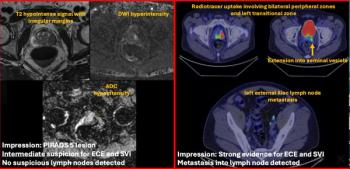
Vertebroplasty spells relief for back pain
Residual questions about vertebroplasty's safety and efficacy were put to rest at the 2005 ECR. Dr. Giovanni C. Anselmetti, medical director of the Interventional Radiology Service of Candiolo in Torino, Italy, announced results of a seven-center trial that included 1580 vertebroplasty patients.
Residual questions about vertebroplasty's safety and efficacy were put to rest at the 2005 ECR. Dr. Giovanni C. Anselmetti, medical director of the Interventional Radiology Service of Candiolo in Torino, Italy, announced results of a seven-center trial that included 1580 vertebroplasty patients.
Of that total, 74% of the patients underwent vertebroplasty for pain caused by osteoporotic vertebral fractures, and 9% had fractures associated with neoplastic disease. The remainder had either angioma or injury from trauma.
Interventions involved fluoroscopy-guided percutaneous injection of cement to seal fractures in up to six spinal vertebrae. Routine follow-up CT evaluated possible leakage.
The trial demonstrated that vertebroplasty nearly always delivers spinal pain relief. Anselmetti found that 92% of patients experienced substantial pain abatement within 48 hours of the procedure:
- 98% of patients with osteoporosis reported a reduction of at least two points in a self-reported scale describing their level of pain;
- 70% of cancer patients said their back pain was reduced substantially; and
- all of the angioma and trauma patients reported major pain relief.
No percutaneous intervention caused major neurologic damage, but 12 patients were treated for asymptomatic cement pulmonary emboli, and 439, or 39%, of the cases involved venous and disc leakage. In six cases, the interventionalists addressed a subcutaneous hematoma during follow-up, and local steroid injection successfully relieved 10 patients of residual pain.
During the same session, Dr. Johannes Hierholzer, a professor of interventional radiology at the University of Potsdam in Germany, presented data assuring fellow interventionalists that vertebroplasty rarely precedes secondary fractures.
Based on the experience of 237 patients at his clinic, Hierholzer found a 13% rate of secondary fractures in the year following surgery. One-third of those fractures were detected in the three months after vertebroplasty. Another 41% occurred between three and six months after the intervention.
Potsdam's secondary fracture rate is about double the composite 7% rate reported by various physicians in the medical literature, Hierholzer said, and it is somewhat higher than the 9% rates reported by the Interventional Radiology Service of Candiolo. He found a Texas service that has a 23% rate of secondary fractures.
Hierholzer could not identify a discernible pattern for secondary fractures along the spine or a relationship with the repair site where secondary fractures may appear. The highest incidences occurred at the T11 and T4 vertebrae, but Hierholzer could not find any reason for a concentration of fractures at those sites. Fractures were slightly more likely to occur above the repair site than below.
Hierholzer sees no need for prophylactic vertebroplasty to anticipate fracture, even for so-called sandwich vertebrae located between vertebroplasty sites. He found no evidence to support prophylactic treatment of such sites, although some experts in this field advocate that approach.
Newsletter
Stay at the forefront of radiology with the Diagnostic Imaging newsletter, delivering the latest news, clinical insights, and imaging advancements for today’s radiologists.




























